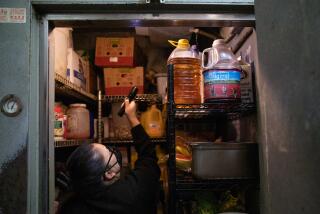High Time to Get Rid of ‘Sniff and Poke’ Meat Checks
- Share via
The Meat Inspection Act was passed by Congress in 1906, not long after Upton Sinclair published his muckraking novel “The Jungle,” with its graphic depiction of what went on in Chicago’s slaughterhouses. One of the book’s many readers was President Theodore Roosevelt who, revolted by the descriptions of diseased animals being processed in filthy conditions, demanded prompt legislative action. As the humorist Finley Peter Dunne imagined the scene, speaking through his wonderful Irish-accented creation, Mr. Dooley, “Tiddy was toying with a light breakfast an’ idly turnin’ over th’ pages iv th’ new book with both hands. Suddenly he rose fr’m th’ table, an’ cryin’: ‘I’m pizzened,’ begun throwin’ sausages ou iv th’ window . . . .” Thus, more or less, was born a major public health reform.
The Clinton administration is now preparing to launch a clearly needed overhaul of the federal meat inspection program. For the first time, scientific tests will be used in place of traditional “sniff and poke” inspections to detect and prevent food contamination in slaughtering plants. Over a period of years, every plant, beginning with the largest, will be required to test for the presence of salmonella and E. coli bacteria. Salmonella can cause sometimes fatal food poisoning. E. coli, whose presence in food indicates fecal contamination, can also be deadly in some cases. Millions of people are sickened by exposure to these bacteria every year, with more than 4,000 deaths attributed to salmonella. Besides beef and pork, the government is also setting performance standards for poultry and lamb.
If Sinclair’s novel was the inspiration for federal action 90 years ago, the deaths of several children in the Pacific Northwest in 1993 from E. coli poisoning traced to undercooked hamburgers was the incentive for the latest reforms. The new rules make slaughterhouses and packers responsible for identifying where contamination could occur and taking steps to prevent it, with oversight from federal inspectors. Many major companies are already operating such systems.
Eventually, the cost to the industry could reach $100 million a year. That will certainly be passed on to consumers. But spread over billions of animals processed by these plants each year, the added costs should be nominal. The anticipated results in any case are well worth slightly higher meat and poultry prices. Here is an example where the public interest is unarguably served by government regulation.
More to Read
Sign up for our Book Club newsletter
Get the latest news, events and more from the Los Angeles Times Book Club, and help us get L.A. reading and talking.
You may occasionally receive promotional content from the Los Angeles Times.









